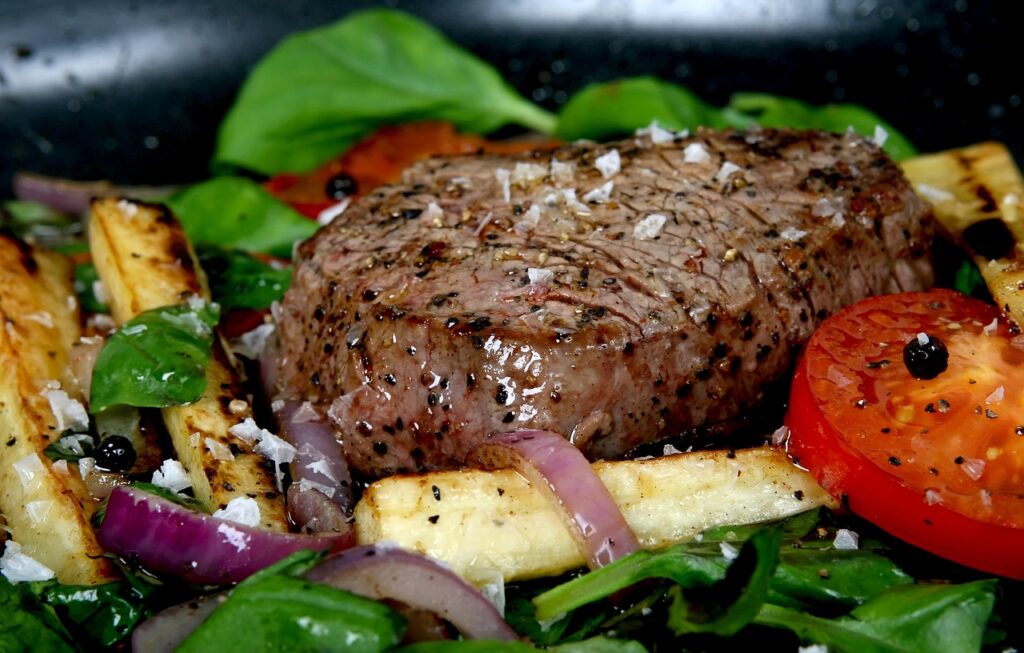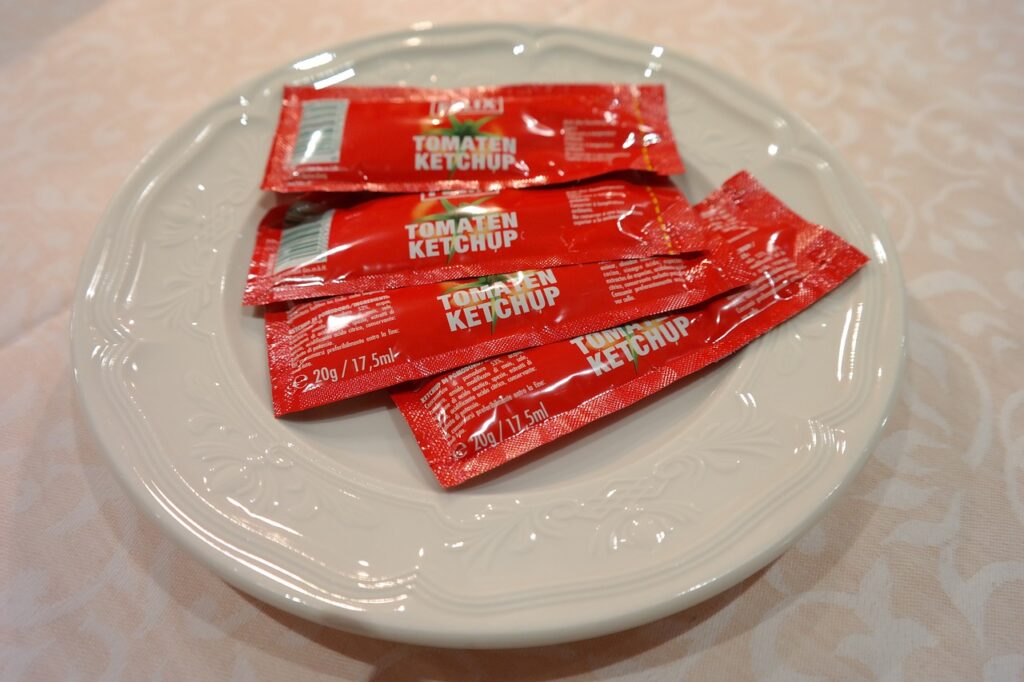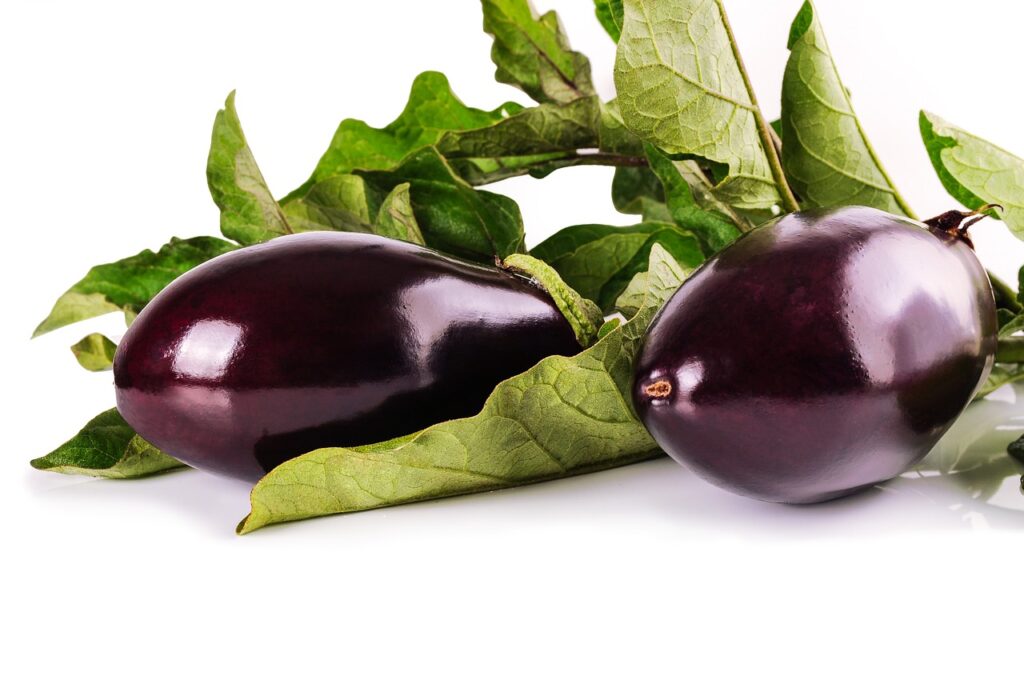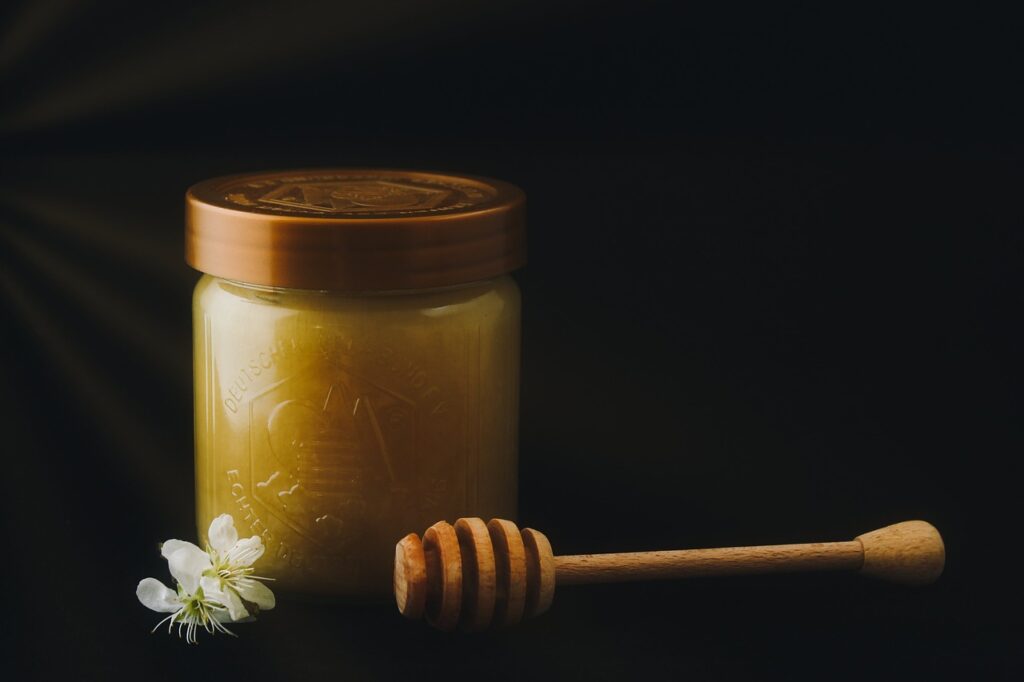When you're exploring healthy keto bread, knowing the ingredients is key. Low-carb flours like almond and coconut flour keep your carb count down while adding healthy fats and protein. Binding agents like eggs or aquafaba provide moisture and stability. Leavening agents such as baking powder help achieve that light, fluffy texture you love. Don't forget nutritional additives like flaxseed meal for omega-3s and fiber. Also, be mindful of allergens, as almond flour and eggs can be problematic for some. If you keep going, you'll discover more tips for perfecting your keto bread baking journey.
Importance of Ingredients
When it comes to healthy keto bread, the choice of ingredients can make all the difference in both flavor and nutrition. Using almond flour is essential because it offers a low-carb alternative to traditional wheat flour, resulting in a net carb count of only 2 to 5 grams per slice. This makes it an excellent option for those watching their carb intake.
Additionally, incorporating nut-based flours like hazelnut or walnut flour can enhance the flavor while maintaining low carbohydrate levels.
Coconut flour is another significant ingredient, known for its high absorbency and fiber content. However, it should be used alongside almond flour due to its density, with a suggested ratio of 3/4 cup almond flour for every 1 cup of coconut flour.
Psyllium husk powder is often included to mimic gluten's elasticity, enhancing the bread's structure and texture.
Don't forget the eggs! They act as a binding agent, providing moisture and helping the bread rise. Plus, there are various options for those with dietary restrictions.
Lastly, the choice of fats, like unsalted butter or coconut oil, not only adds flavor but also keeps the bread low carb while delivering essential nutrients, making it satisfying and nutritious.
Key Low-Carb Flours
Choosing the right low-carb flours is essential for creating delicious and healthy keto bread. Almond flour is a favorite, with only 2 grams of net carbs per 1/4 cup, plus it's packed with healthy fats and protein. Its low carbohydrate content also helps stabilize blood sugar levels, making it an excellent choice for blood sugar management.
Coconut flour, while more absorbent and containing about 6 grams of net carbs per 1/4 cup, requires you to adjust liquid ratios in your keto recipes to get the right texture.
Flaxseed meal is another excellent choice, offering just 1 gram of net carbs per 2 tablespoons while adding omega-3 fatty acids and dietary fiber to your baked goods.
If you're looking to mimic the elasticity of gluten, psyllium husk powder is a must-have in your pantry. It contributes minimal net carbs and enhances the overall texture of your low carb breads.
Essential Binding Agents
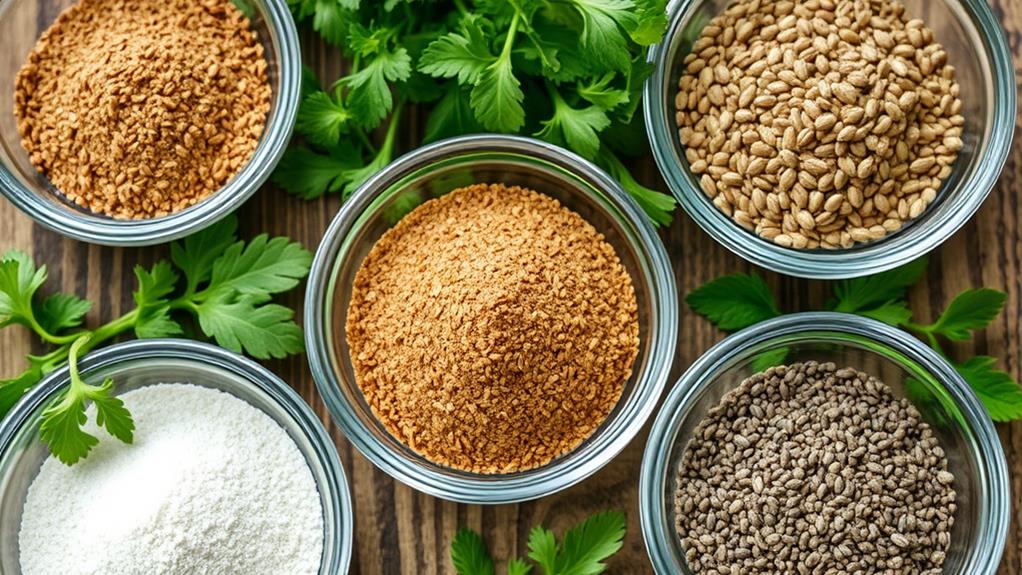
When you're making keto bread, binding agents play a vital role in achieving the right texture.
Utilizing ingredients like almond flour enhances moisture and provides a rich flavor, while psyllium husk adds chewiness and structure to the bread.
Egg whites add lightness and structure, while almond flour contributes moisture and flavor.
Don't forget about baking powder, which helps the bread rise and creates a fluffy consistency.
Role of Egg Whites
Egg whites play a significant role in keto bread recipes, acting as essential binding agents that provide structure and stability. When whipped to stiff peaks, egg whites incorporate air into the batter, creating a light and fluffy texture that's often lacking in low-carb flours. This aeration is critical for achieving the desired rise, ensuring your keto bread doesn't become dense or crumbly.
The binding properties of egg whites help hold all the ingredients together, preventing the common issue of crumbliness seen with many low-carb alternatives. Additionally, the protein content in egg whites—about 3.6 grams per egg white—significantly enhances the nutritional profile of your keto bread while keeping it low in carbohydrates.
If you're looking for an egg alternative, aquafaba can mimic some of these binding properties, though the results may not be as reliable.
Ultimately, using egg whites is an effective way to elevate your keto bread, giving it the structure and texture you crave while maintaining its health benefits. So, don't skip the egg whites; they're essential for a successful keto bread experience!
Importance of Almond Flour
Almond flour stands out as an essential ingredient in keto bread, delivering a low-carb alternative to traditional wheat flour with only around 2 grams of net carbs per slice. This makes it perfect for anyone following a ketogenic diet.
Here's why almond flour is so significant:
- Low-Carb Option: Almond flour helps you maintain ketosis while enjoying your favorite bread.
- Healthy Fats: With about 14 grams of healthy fats per 1/4 cup, it aligns perfectly with your high-fat dietary needs.
- Protein-Rich: It contains roughly 6 grams of protein per 1/4 cup, supporting muscle maintenance and keeping you full longer.
- Binding Agent: As a gluten-free option, almond flour acts as a vital binding agent, ensuring your keto bread has structure and moisture.
Additionally, almond flour contributes to a light and fluffy texture in keto bread due to its fine grind, creating air pockets that mimic traditional bread.
Benefits of Baking Powder
Baking powder serves as an essential leavening agent in keto bread, helping you achieve that light and fluffy texture you crave. It's a combination of an acid, like cream of tartar, and a base, such as baking soda. When mixed with liquid and heated, it releases carbon dioxide gas, creating the lift you need for perfect keto bread.
Freshness is vital when using baking powder. If it's past its expiration date, you might end up with dense bread due to insufficient leavening. Unlike baking soda, which requires an acidic ingredient to activate, baking powder is double-acting. This means it starts working as soon as you mix it and continues to react in the oven, ensuring a better rise.
For ideal structure and texture, the recommended amount of baking powder in keto bread recipes is about 1 teaspoon per cup of flour. This balance allows the baking powder to elevate your bread without overpowering its flavor.
Role of Leavening Agents
When making keto bread, leavening agents play an essential role in achieving that light, airy texture you want.
Freshness is key—using expired baking powder can leave your bread dense and flat.
The choice of ingredients, like nutritious alternatives, also impacts the bread's texture and flavor profile.
You'll want to understand the different types of leavening agents and how they affect your bread's overall quality.
Importance of Freshness
Fresh leavening agents are essential for achieving the perfect rise and texture in your keto bread. When you use expired baking powder, it can fail to produce the gas needed to lift your dough, resulting in a dense loaf.
To guarantee your keto bread turns out light and fluffy, keep these points in mind:
- Check Freshness: Always use fresh leavening agents; replace baking powder every 6-12 months.
- Proper Storage: Store baking powder in a cool, dry place to maintain its effectiveness.
- Activation Process: The combination of baking powder and moisture activates carbon dioxide production, creating air pockets necessary for that desired texture.
- Monitor Internal Temperature: Aim for an internal temperature of around 200°F to confirm that the leavening agents have properly done their job.
In keto bread, the absence of gluten means that leavening agents play a more significant role than in traditional bread.
Types of Leavening Agents
Leavening agents play an essential role in creating the perfect texture for keto bread. These substances cause the dough to rise by producing gas, mainly carbon dioxide, which forms air pockets in the bread. This results in a light and fluffy structure that you desire.
Common leavening agents in keto bread recipes include baking powder. This ingredient combines an acid and a base, triggering a chemical reaction that releases gas when mixed with moisture and heat.
Unlike traditional bread that often uses yeast, keto bread usually avoids it due to the higher carbohydrate content. Instead, you can rely on baking powder or whipped egg whites to achieve the necessary rise.
Remember, the effectiveness of your leavening agents depends on their freshness; expired baking powder won't provide the lift you need, leading to denser bread.
Proper measurement and mixing are vital, too. Using too much can cause excessive rise, resulting in collapse, while too little will yield flat, dense bread.
Effects on Texture
The texture of keto bread hinges on the role of leavening agents, which create carbon dioxide bubbles during baking.
These bubbles help the bread rise, giving it a light, fluffy texture that mimics traditional bread. Since keto bread often uses almond flour and coconut flour—both gluten-free—it's essential to understand how to optimize these ingredients for the best results.
- Use Fresh Leavening Agents: Stale baking powder won't produce enough gas, leading to denser bread.
- Whip Egg Whites: Properly whipping egg whites to stiff peaks and gently folding them into the batter can enhance the bread's airiness.
- Monitor Baking Time: Keeping a close eye on your baking time guarantees you don't overbake, which can dry out the bread.
- Check Internal Temperature: Aim for an internal temperature of around 200°F; this helps retain moisture and achieve the desired texture.
Nutritional Additives
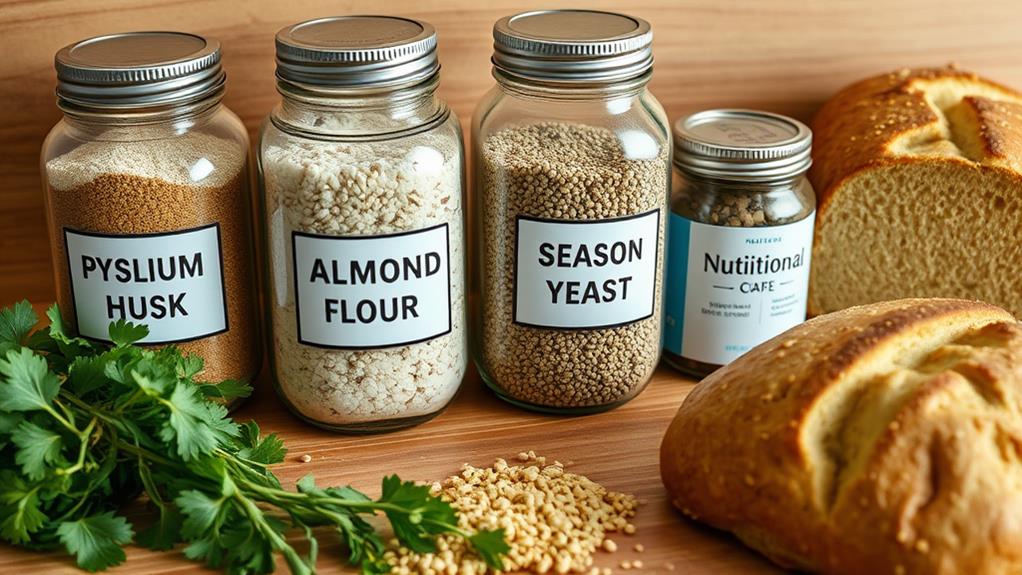
Many keto bread recipes include nutritional additives that enhance both texture and health benefits. One of the most popular is psyllium husk powder, which boosts the fiber content and mimics the elasticity of gluten, resulting in a more satisfying texture.
Additionally, incorporating high-protein meat alternatives like hemp seeds can provide extra protein and healthy fats, complementing the overall nutritional profile of your bread. Flaxseed meal is another excellent choice, providing omega-3 fatty acids and extra fiber to support digestive health.
You might also encounter nutritional yeast in some recipes. It's rich in B vitamins and gives your bread a cheesy flavor without adding carbs.
For added nutritional value, consider incorporating seeds like chia or sunflower seeds. These not only provide healthy fats and protein but also add a delightful crunch.
If you're looking to increase the protein content of your keto bread, unflavored protein powders can be a great addition. They make the bread more satiating and help keep you on track with your low-carb diet.
Flavor Enhancers
Adding flavor enhancers can transform your keto bread from bland to extraordinary. By incorporating the right ingredients, you can create a loaf that's not only delicious but also aligns with your dietary needs.
For those following a keto diet, it's important to contemplate options that are low in carbs while still providing a satisfying taste. Incorporating low-carb options like pepperoni can add a unique flavor profile to your bread.
Here are some fantastic flavor enhancers to contemplate:
- Garlic Powder – This adds a robust, savory flavor that elevates the taste of your bread.
- Apple Cider Vinegar – A splash can enhance overall flavor and improve leavening, resulting in a lighter texture.
- Cheese – Using cheddar or parmesan not only boosts the savory flavor but also increases healthy fats, making your bread even more satisfying.
- Seeds – Incorporate sesame or sunflower seeds for added crunch, flavor, and nutritional value through healthy fats and fiber.
These flavor enhancers can greatly elevate your keto bread experience.
Whether you're opting for a savory or slightly sweet variation, these ingredients will help you achieve the perfect balance of taste and texture, ensuring that your bread is anything but ordinary.
Common Substitutions
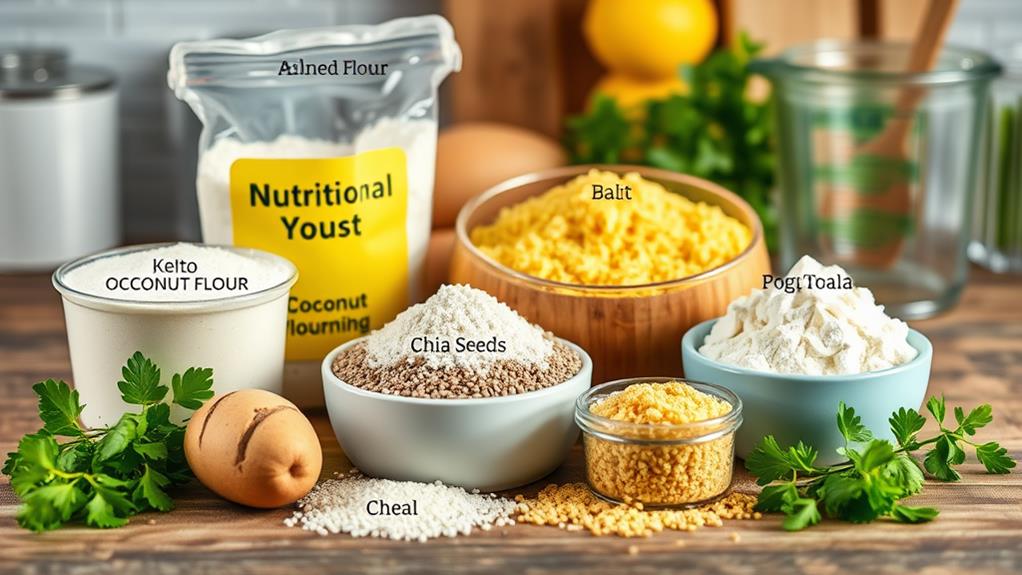
When making healthy keto bread, you might find yourself needing to swap out certain ingredients.
Understanding essential alternatives and flavor adjustments can help you customize your recipe to fit your preferences without compromising quality.
Let's explore some common substitutions that can keep your bread both delicious and keto-friendly.
Essential Ingredient Alternatives
Finding the right ingredient alternatives for healthy keto bread can make all the difference in your baking experience. Here are some essential substitutes to take into account:
- Almond Flour: This is a staple in keto bread recipes due to its low carb content and high healthy fat profile. If you're out of almond flour, coconut flour can be used, but remember, it can't be substituted 1:1. Use three-quarters of a cup of almond flour instead.
- Unsalted Butter: While it adds rich flavor, you can replace unsalted butter with coconut oil for a dairy-free option or olive oil for a lighter taste.
- Egg Whites: Essential for structure, fresh egg whites are preferred, but carton egg whites can work in a pinch.
- Lemon Juice: If you don't have cream of tartar on hand, lemon juice serves as a great substitute, offering similar acid properties needed for stabilizing whipped egg whites.
Flavor Enhancements and Adjustments
Flavor enhancements and adjustments can greatly elevate your keto bread, making it more enjoyable and unique. One easy way to alter the taste is through cheese variations. For instance, using cheddar instead of mozzarella can change the flavor profile and texture substantially.
Sweetener substitutes can also help; you might try allulose, a low-calorie sweetener, in place of raw honey for a delightful sweetness without the carbs.
Consider a flaxseed addition as well. Ground flaxseed enhances the nutty flavor while boosting nutritional content with omega-3 fatty acids and fiber.
Don't overlook herbs and spices either! Adding dried rosemary or garlic powder can provide aromatic notes that elevate your bread without adding carbs.
Lastly, think about nut butter infusion. Swapping some fat with almond or peanut butter offers a rich flavor and moist texture, plus it contributes healthy fats.
Allergen Considerations
Steering through allergen considerations is vital when making healthy keto bread, as many recipes rely on common allergens. If you're preparing keto bread, keep these key points in mind to accommodate dietary restrictions and avoid potential reactions:
- Almond Flour: This is a staple in many keto recipes, but it's a common allergen for those with tree nut allergies. Always check with your guests before serving.
- Egg Allergies: Many recipes use eggs as a binding agent. If anyone has egg allergies or sensitivities, consider alternatives.
- Dairy Ingredients: Ingredients like cream cheese or butter can pose risks for those with lactose intolerance or dairy allergies.
- Allergen Warnings: If you're buying store-bought keto bread, always check the packaging for allergen warnings to avoid cross-contamination.
To make your bread more inclusive, you can substitute allergens with alternatives. For example, replace eggs with flaxseed meal and use coconut oil instead of butter.
These adjustments can help guarantee everyone can enjoy your healthy keto bread without worry!
Storage and Freshness
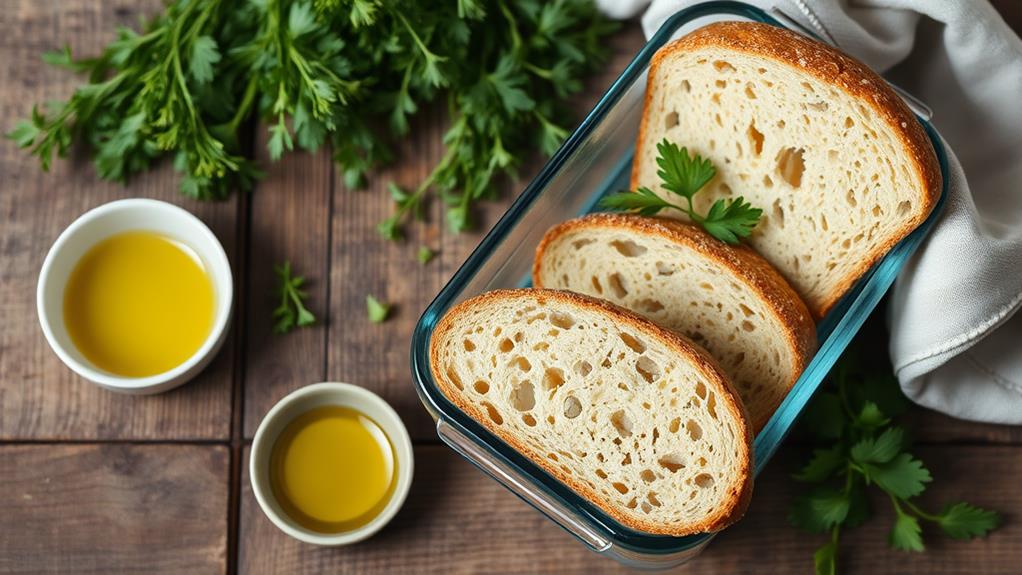
When you've successfully prepared allergen-friendly keto bread, knowing how to store it properly guarantees it stays fresh and delicious. For short-term storage, place your keto bread in an airtight container after wrapping it in parchment paper. This method helps maintain its freshness for up to one week in the refrigerator.
If you want to preserve your keto bread for a longer period, freezing is your best bet. You can freeze it for up to six months, but make sure to slice the bread before freezing. Separating each slice with parchment paper prevents sticking and makes it easy to grab just what you need.
Before refrigerating or freezing, verify your keto bread is completely cooled. This step is essential to avoid moisture buildup, which can lead to sogginess.
By using airtight packaging, you protect your bread from air exposure that causes it to dry out or develop freezer burn. Remember, slice your keto bread as needed rather than all at once to keep its texture intact and maintain that delightful freshness.
Proper storage makes all the difference in enjoying your delicious keto bread!
Recipe Variations
If you're looking to shake up your keto bread routine, exploring recipe variations can lead to delightful new flavors and textures. By experimenting with different ingredients, you can tailor your bread to suit your taste and nutritional needs.
Here are some tasty ideas to get you started:
- Savory Additions: Incorporate flavor enhancers like garlic powder, herbs, or even shredded cheese for a savory twist.
- Low-Carb Flour Swaps: Substitute almond flour with coconut flour or flaxseed meal. Just remember, coconut flour absorbs more moisture, so adjust your liquid ingredients accordingly.
- Sweet Variations: For a sweeter bread, add cinnamon, vanilla extract, or low-carb sweeteners like erythritol or stevia.
- Nutrient Boosters: Enhance the nutritional value by mixing in vegetables like shredded zucchini or spinach, or add unflavored protein powder or Greek yogurt for extra protein.
These recipe variations not only diversify your keto bread options but also allow you to enjoy a delicious, low-carb treat that meets your dietary goals.
Get creative and find your favorite combinations!
Conclusion
In your quest for quality keto bread, remember that choosing the right components can create a delightful, delicious dish. Prioritize perfect low-carb flours, binding brilliance, and leavening legends to elevate your baking. Don't forget to reflect on nutritional nuances and allergen awareness for a wholesome experience. With clever substitutions and smart storage, you'll savor scrumptious slices that support your healthy lifestyle. So, go ahead and bake boldly—your taste buds will thank you!


